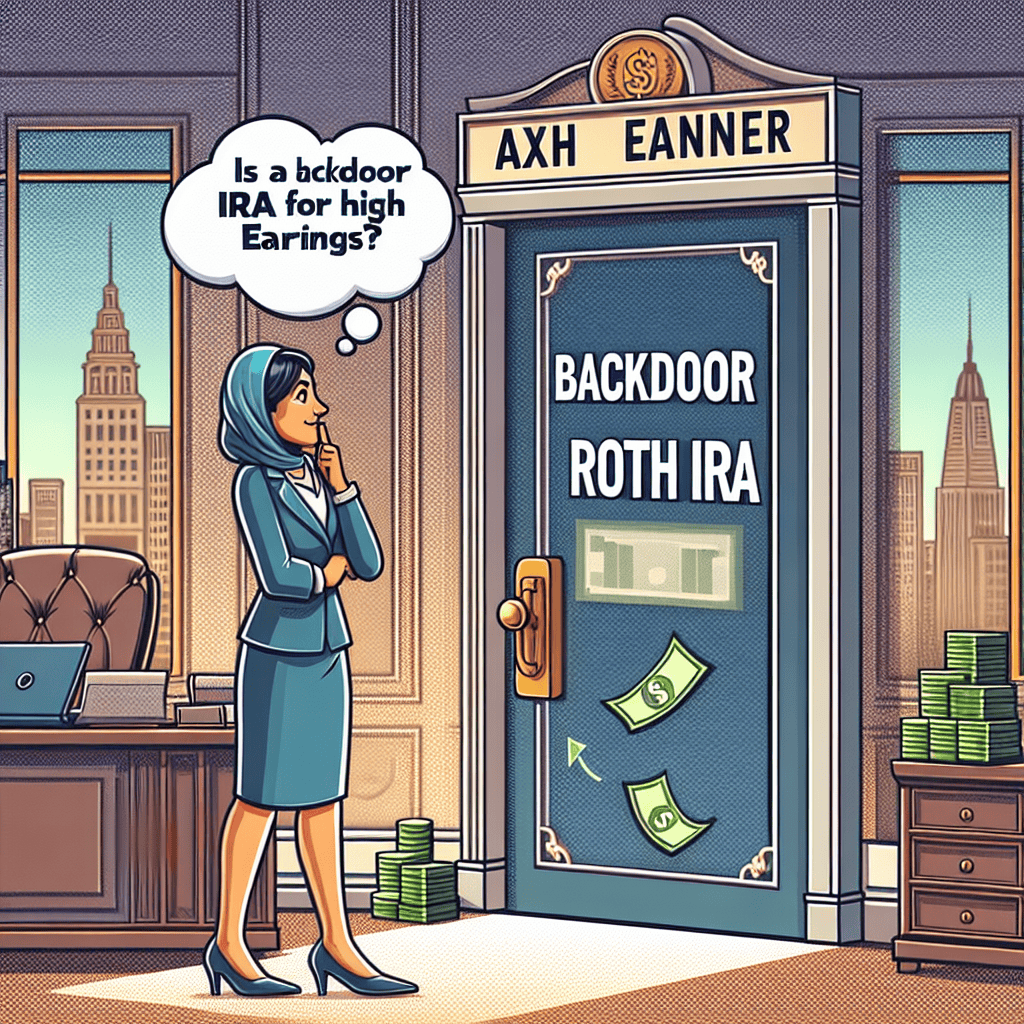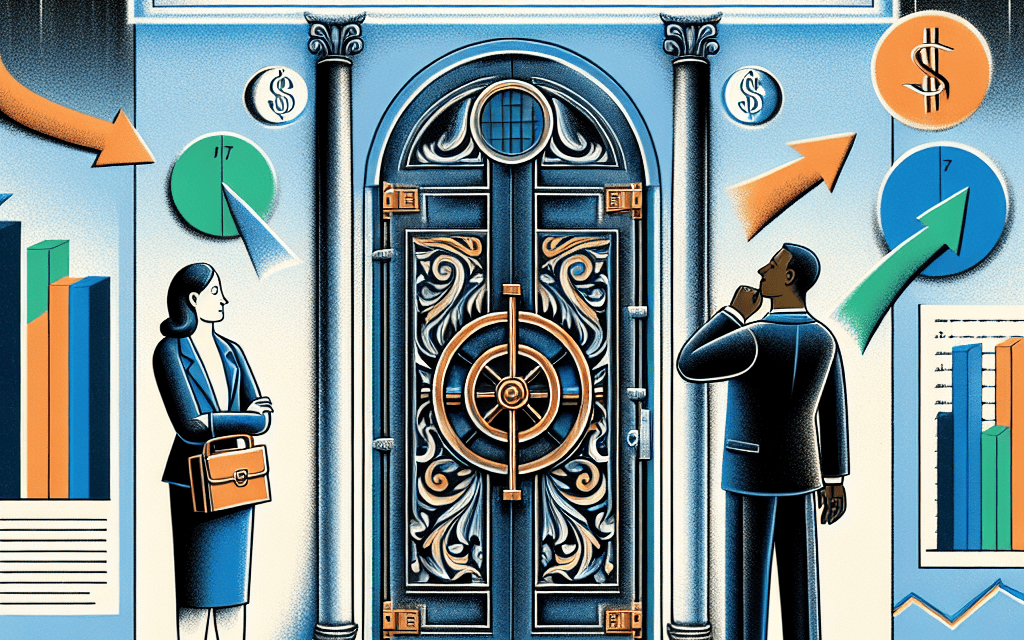“Unlock Tax-Free Growth: Discover if a Backdoor Roth IRA is Your Key to Maximizing Savings.”
Introduction
Maximizing tax savings is a critical consideration for high earners seeking to optimize their financial strategies. One potential avenue for achieving this goal is the Backdoor Roth IRA, a unique retirement savings tool that allows individuals with high incomes to circumvent the income limits typically associated with Roth IRA contributions. This strategy involves making nondeductible contributions to a traditional IRA and subsequently converting those funds into a Roth IRA, thereby enabling high earners to benefit from the tax-free growth and withdrawals that Roth IRAs offer. However, the Backdoor Roth IRA is not without its complexities and potential pitfalls, making it essential for individuals to thoroughly understand the process and evaluate whether it aligns with their broader financial objectives. This introduction explores the intricacies of the Backdoor Roth IRA and assesses its suitability as a tax-saving strategy for high-income individuals.
Understanding the Basics of a Backdoor Roth IRA
A Backdoor Roth IRA is a strategic financial tool that can be particularly beneficial for high earners seeking to maximize their tax savings. Understanding the basics of this approach is essential for those who are ineligible to contribute directly to a Roth IRA due to income limitations. The Backdoor Roth IRA offers a legal workaround, allowing individuals to enjoy the benefits of a Roth IRA, such as tax-free growth and tax-free withdrawals in retirement, without being hindered by income restrictions.
To comprehend how a Backdoor Roth IRA functions, it is important to first understand the traditional IRA and Roth IRA. A traditional IRA allows individuals to make pre-tax contributions, which can reduce taxable income in the year of contribution. However, withdrawals during retirement are taxed as ordinary income. In contrast, a Roth IRA requires after-tax contributions, but qualified withdrawals are tax-free, providing a significant advantage for those anticipating higher tax rates in the future. Unfortunately, the ability to contribute directly to a Roth IRA is phased out for high earners, with income limits set by the IRS.
This is where the Backdoor Roth IRA comes into play. The process involves making a nondeductible contribution to a traditional IRA, which does not have income limits, and then converting those funds to a Roth IRA. This conversion is not subject to income restrictions, making it an attractive option for high-income individuals. However, it is crucial to be aware of the tax implications associated with this strategy. When converting funds from a traditional IRA to a Roth IRA, any pre-tax contributions and earnings are subject to income tax in the year of conversion. Therefore, it is often advantageous to convert funds that have not yet appreciated significantly, minimizing the tax burden.
Moreover, the pro-rata rule must be considered when executing a Backdoor Roth IRA. This rule requires that all traditional IRAs be considered as one when calculating the taxable portion of a conversion. Consequently, if an individual has other traditional IRAs with pre-tax contributions, a portion of the conversion will be taxable, potentially complicating the strategy. To mitigate this, some individuals choose to roll over existing pre-tax IRA funds into an employer-sponsored retirement plan, such as a 401(k), if allowed, thereby isolating the nondeductible contributions for conversion.
In addition to understanding the mechanics and tax implications, it is essential to consider the long-term benefits of a Backdoor Roth IRA. The primary advantage lies in the tax-free growth and withdrawals, which can significantly enhance retirement savings. Furthermore, Roth IRAs do not have required minimum distributions (RMDs) during the account holder’s lifetime, allowing for greater flexibility in retirement planning. This feature can be particularly beneficial for high earners who may not need to access their retirement funds immediately.
In conclusion, while a Backdoor Roth IRA can be a valuable tool for high earners seeking to maximize tax savings, it requires careful planning and consideration of various factors. Understanding the process, tax implications, and long-term benefits is crucial to making an informed decision. By navigating these complexities, high-income individuals can effectively leverage a Backdoor Roth IRA to enhance their retirement savings strategy, ultimately achieving greater financial security in their later years.
Eligibility Criteria for High Earners Considering a Backdoor Roth IRA
When considering strategies to maximize tax savings, high earners often explore various retirement account options. One such strategy that has gained popularity is the Backdoor Roth IRA. This approach allows individuals with incomes exceeding the limits for direct Roth IRA contributions to still benefit from the advantages of a Roth IRA. However, before proceeding with this strategy, it is crucial to understand the eligibility criteria and the nuances involved in executing a Backdoor Roth IRA effectively.
To begin with, it is important to recognize that a Backdoor Roth IRA is not a separate type of account but rather a method of contributing to a Roth IRA indirectly. This process involves making a nondeductible contribution to a traditional IRA and subsequently converting those funds to a Roth IRA. The primary eligibility criterion for a Backdoor Roth IRA is the income level of the individual. For 2023, the IRS stipulates that single filers with a modified adjusted gross income (MAGI) exceeding $153,000 and married couples filing jointly with a MAGI over $228,000 are ineligible to contribute directly to a Roth IRA. Therefore, high earners who fall into these categories may consider the Backdoor Roth IRA as a viable alternative.
Moreover, it is essential to consider the contribution limits set by the IRS. For 2023, individuals can contribute up to $6,500 to an IRA, with an additional $1,000 catch-up contribution allowed for those aged 50 and above. These limits apply to the total contributions made to both traditional and Roth IRAs. Consequently, high earners must ensure that their contributions do not exceed these limits when executing a Backdoor Roth IRA strategy.
In addition to income and contribution limits, another critical factor to consider is the pro-rata rule. This rule affects individuals who have existing traditional, SEP, or SIMPLE IRA balances. The pro-rata rule requires that the conversion of nondeductible contributions to a Roth IRA be proportionate to the total balance of all traditional IRAs. This means that if an individual has pre-tax funds in any traditional IRA, the conversion will be subject to taxation based on the ratio of nondeductible to total IRA balances. Therefore, high earners with significant pre-tax IRA balances may face unexpected tax liabilities when executing a Backdoor Roth IRA.
Furthermore, timing plays a crucial role in the successful execution of a Backdoor Roth IRA. It is advisable to complete the conversion from a traditional IRA to a Roth IRA promptly after making the nondeductible contribution. This minimizes the potential for investment gains, which would be subject to taxation upon conversion. By acting swiftly, high earners can ensure that the conversion process remains as tax-efficient as possible.
In conclusion, while a Backdoor Roth IRA presents an attractive opportunity for high earners to maximize tax savings and enjoy the benefits of tax-free growth and withdrawals in retirement, it is imperative to carefully evaluate the eligibility criteria and potential tax implications. By understanding the income limits, contribution caps, pro-rata rule, and timing considerations, high earners can make informed decisions and effectively implement a Backdoor Roth IRA strategy. As with any financial decision, consulting with a tax advisor or financial planner is recommended to tailor the approach to individual circumstances and ensure compliance with IRS regulations.
Step-by-Step Guide to Setting Up a Backdoor Roth IRA
For high earners seeking to maximize their tax savings, a Backdoor Roth IRA presents a compelling opportunity. This strategy allows individuals who exceed the income limits for direct Roth IRA contributions to still benefit from the tax advantages of a Roth account. Understanding the step-by-step process of setting up a Backdoor Roth IRA is crucial for those looking to optimize their retirement savings.
To begin, it is essential to grasp the fundamental concept of a Backdoor Roth IRA. Essentially, this involves making a nondeductible contribution to a traditional IRA and subsequently converting those funds into a Roth IRA. The primary advantage of a Roth IRA is that, while contributions are made with after-tax dollars, the earnings grow tax-free, and qualified withdrawals in retirement are also tax-free. This can be particularly beneficial for high earners who anticipate being in a higher tax bracket during retirement.
The first step in setting up a Backdoor Roth IRA is to open a traditional IRA account if you do not already have one. This can be done through most financial institutions, and it is advisable to choose one that offers a wide range of investment options and low fees. Once the account is established, the next step is to make a nondeductible contribution. For 2023, the maximum contribution limit is $6,500, or $7,500 for those aged 50 and above. It is important to note that this contribution is made with after-tax dollars, meaning it will not reduce your taxable income for the year.
After making the contribution, the next step is to convert the traditional IRA to a Roth IRA. This can typically be done online through your financial institution’s platform. During the conversion process, you will need to pay taxes on any earnings that have accrued in the traditional IRA since the contribution was made. However, if the conversion is done shortly after the contribution, the tax liability is often minimal.
It is crucial to be aware of the pro-rata rule when executing a Backdoor Roth IRA conversion. This rule requires that all traditional, SEP, and SIMPLE IRAs be considered when calculating the taxable portion of the conversion. If you have other traditional IRAs with pre-tax contributions, this could complicate the tax implications of the conversion. To mitigate this, some individuals choose to roll over their pre-tax IRA funds into an employer-sponsored 401(k) plan, if available, before executing the Backdoor Roth conversion.
Once the conversion is complete, it is important to keep detailed records of the transaction. This includes documentation of the original nondeductible contribution and the subsequent conversion. These records will be necessary for accurately filing IRS Form 8606, which reports nondeductible contributions to traditional IRAs and calculates the taxable portion of the conversion.
In conclusion, while the process of setting up a Backdoor Roth IRA involves several steps and careful consideration of tax implications, it can be a highly effective strategy for high earners to maximize their retirement savings. By understanding and following the necessary steps, individuals can take advantage of the tax-free growth and withdrawals offered by a Roth IRA, ultimately enhancing their financial security in retirement. As with any financial strategy, it is advisable to consult with a tax professional or financial advisor to ensure that a Backdoor Roth IRA aligns with your overall financial goals and circumstances.
Potential Tax Implications of a Backdoor Roth IRA

A Backdoor Roth IRA can be an attractive option for high earners seeking to maximize their tax savings, but it is essential to understand the potential tax implications associated with this strategy. As income levels rise, individuals often find themselves ineligible to contribute directly to a Roth IRA due to income limits. However, the Backdoor Roth IRA offers a legal workaround, allowing high-income earners to enjoy the benefits of tax-free growth and withdrawals in retirement. This strategy involves making a nondeductible contribution to a traditional IRA and subsequently converting those funds to a Roth IRA. While this process seems straightforward, it is crucial to consider the tax implications that may arise.
One of the primary tax considerations is the pro-rata rule, which can complicate the conversion process. The pro-rata rule requires that all traditional IRAs be considered as one when calculating the taxable portion of a conversion. This means that if an individual has pre-tax funds in any traditional IRA, SEP IRA, or SIMPLE IRA, a portion of the conversion will be taxable. For instance, if a person has $5,000 in nondeductible contributions and $15,000 in pre-tax funds across their IRAs, 75% of any conversion would be taxable. This can lead to unexpected tax liabilities, diminishing the benefits of the Backdoor Roth IRA.
Moreover, it is important to be aware of the timing of contributions and conversions. The IRS does not impose a specific waiting period between making a nondeductible contribution to a traditional IRA and converting it to a Roth IRA. However, executing these transactions too closely together may raise red flags, potentially leading to scrutiny from the IRS. To mitigate this risk, some financial advisors recommend waiting a short period between the contribution and conversion, although this is not a legal requirement.
Another consideration is the potential impact on Medicare premiums. High-income retirees may face increased Medicare Part B and Part D premiums, known as Income-Related Monthly Adjustment Amounts (IRMAA). Since Roth IRA conversions increase taxable income in the year of conversion, they can inadvertently push individuals into higher income brackets, resulting in elevated Medicare premiums. Therefore, it is advisable to carefully plan the timing and amount of conversions to avoid unintended consequences on healthcare costs.
Furthermore, individuals should consider the long-term benefits of a Backdoor Roth IRA. While the initial conversion may result in a tax liability, the advantage of tax-free growth and withdrawals in retirement can outweigh the upfront costs. This is particularly beneficial for those who anticipate being in a higher tax bracket during retirement or who wish to leave a tax-free inheritance to their heirs. Additionally, Roth IRAs do not have required minimum distributions (RMDs) during the account holder’s lifetime, allowing for greater flexibility in retirement planning.
In conclusion, while a Backdoor Roth IRA can be a valuable tool for high earners seeking to maximize tax savings, it is essential to navigate the potential tax implications carefully. Understanding the pro-rata rule, timing considerations, and the impact on Medicare premiums is crucial to making informed decisions. By weighing the immediate tax costs against the long-term benefits, individuals can determine whether this strategy aligns with their financial goals. Consulting with a tax professional or financial advisor can provide personalized guidance, ensuring that the Backdoor Roth IRA is implemented effectively and in accordance with individual circumstances.
Comparing Traditional IRA vs. Backdoor Roth IRA for High Earners
When considering retirement savings strategies, high earners often face unique challenges due to income limitations on certain tax-advantaged accounts. One such challenge is the restriction on contributing directly to a Roth IRA, which offers tax-free growth and withdrawals in retirement. For individuals whose income exceeds the Roth IRA contribution limits, a backdoor Roth IRA presents a viable alternative. To determine whether this strategy is advantageous, it is essential to compare it with the traditional IRA, focusing on the potential tax savings and long-term benefits.
A traditional IRA allows individuals to contribute pre-tax dollars, which can reduce taxable income in the year of contribution. The investments within the account grow tax-deferred, meaning taxes are paid upon withdrawal during retirement. This can be beneficial for those who anticipate being in a lower tax bracket in retirement. However, high earners often find themselves in a consistently high tax bracket, both during their working years and in retirement, which can diminish the tax-deferral advantage of a traditional IRA.
In contrast, a backdoor Roth IRA involves a two-step process: contributing to a traditional IRA and then converting those funds to a Roth IRA. This strategy circumvents the income limits associated with direct Roth IRA contributions. While the initial contribution to a traditional IRA may not be tax-deductible for high earners, the subsequent conversion to a Roth IRA allows for tax-free growth and withdrawals, provided certain conditions are met. This can be particularly appealing for those who expect to remain in a high tax bracket throughout their lifetime.
One of the primary considerations when comparing these two options is the tax implications of the conversion process. When converting a traditional IRA to a Roth IRA, taxes are due on any pre-tax contributions and earnings. For high earners, this can result in a significant tax bill in the year of conversion. However, the long-term benefits of tax-free growth and withdrawals in retirement can outweigh the immediate tax cost, especially if the conversion is executed strategically over several years to manage the tax impact.
Another factor to consider is the impact of the pro-rata rule, which affects individuals with existing traditional IRA balances. This rule requires that any conversion to a Roth IRA includes a proportionate share of pre-tax and post-tax dollars across all traditional IRAs. As a result, high earners with substantial pre-tax IRA balances may face a larger tax liability upon conversion. To mitigate this, some individuals choose to roll over pre-tax IRA funds into an employer-sponsored retirement plan, such as a 401(k), before executing a backdoor Roth conversion.
Ultimately, the decision between a traditional IRA and a backdoor Roth IRA hinges on individual financial circumstances and retirement goals. High earners who prioritize tax-free income in retirement and are willing to navigate the complexities of the conversion process may find the backdoor Roth IRA to be a superior option. Conversely, those who prefer immediate tax deductions and anticipate a lower tax bracket in retirement might lean towards a traditional IRA.
In conclusion, while both traditional IRAs and backdoor Roth IRAs offer distinct advantages, high earners must carefully evaluate their current and future tax situations to maximize their retirement savings. By understanding the nuances of each option and considering the long-term implications, individuals can make informed decisions that align with their financial objectives.
Common Mistakes to Avoid When Implementing a Backdoor Roth IRA
When considering a Backdoor Roth IRA as a strategy for maximizing tax savings, high earners must navigate a complex landscape to ensure compliance and effectiveness. This approach, while beneficial, is fraught with potential pitfalls that can undermine its advantages if not carefully managed. One common mistake is neglecting the pro-rata rule, which can significantly impact the tax implications of the conversion process. The pro-rata rule requires that all traditional, SEP, and SIMPLE IRAs be considered when calculating the taxable portion of a Roth conversion. Failing to account for this can lead to unexpected tax liabilities, as the IRS views all IRAs as a single entity for tax purposes. Therefore, it is crucial to understand how existing IRA balances can affect the tax outcome of a Backdoor Roth IRA.
Another frequent error involves the timing of contributions and conversions. Many individuals mistakenly believe that they can contribute to a traditional IRA and immediately convert to a Roth IRA without any tax consequences. However, the IRS requires that the conversion be reported in the tax year it occurs, and any earnings on the contribution before conversion may be subject to taxation. To avoid this, it is advisable to perform the conversion as soon as possible after the contribution, minimizing the potential for taxable earnings to accrue.
Additionally, overlooking the importance of accurate record-keeping can lead to complications. Proper documentation is essential to substantiate the non-deductible contributions made to a traditional IRA, which are then converted to a Roth IRA. This includes filing IRS Form 8606, which tracks the basis of non-deductible contributions. Failure to file this form can result in double taxation, as the IRS may assume that the entire conversion amount is taxable. Therefore, meticulous record-keeping and timely filing are imperative to ensure that the tax benefits of a Backdoor Roth IRA are fully realized.
Moreover, some high earners mistakenly assume that a Backdoor Roth IRA is suitable for everyone in their income bracket. However, individual financial situations vary, and what works for one person may not be ideal for another. It is essential to consider factors such as current and future tax rates, retirement goals, and overall financial strategy before proceeding with a Backdoor Roth IRA. Consulting with a financial advisor or tax professional can provide valuable insights tailored to one’s specific circumstances, helping to avoid costly mistakes.
Furthermore, misunderstanding the contribution limits and eligibility requirements can lead to inadvertent errors. While the Backdoor Roth IRA is a legal strategy for high earners to bypass income limits on Roth IRA contributions, it is still subject to the annual contribution limits set by the IRS. Exceeding these limits can result in penalties, negating the potential tax savings. Therefore, it is vital to stay informed about the current contribution limits and ensure compliance.
In conclusion, while a Backdoor Roth IRA can be an effective tool for high earners seeking to maximize tax savings, it requires careful planning and execution. By understanding and avoiding common mistakes such as neglecting the pro-rata rule, mistiming contributions and conversions, failing to maintain accurate records, assuming universal applicability, and misunderstanding contribution limits, individuals can better position themselves to reap the benefits of this strategy. Engaging with knowledgeable professionals and staying informed about IRS regulations can further enhance the likelihood of a successful implementation, ultimately contributing to a more secure financial future.
Long-Term Benefits of a Backdoor Roth IRA for Wealth Accumulation
For high earners seeking to optimize their retirement savings, the Backdoor Roth IRA presents a compelling opportunity. This strategy allows individuals to bypass the income limits traditionally associated with Roth IRA contributions, thereby enabling them to enjoy the long-term benefits of tax-free growth and withdrawals. As the landscape of retirement planning becomes increasingly complex, understanding the nuances of a Backdoor Roth IRA can be instrumental in maximizing tax savings and enhancing wealth accumulation over time.
To begin with, the Backdoor Roth IRA is particularly advantageous for those whose income exceeds the thresholds set for direct Roth IRA contributions. By utilizing this strategy, high earners can make nondeductible contributions to a traditional IRA and subsequently convert those funds into a Roth IRA. This conversion process effectively circumvents the income restrictions, allowing individuals to benefit from the Roth IRA’s tax-free growth potential. Over the long term, this can result in substantial tax savings, as the earnings within a Roth IRA are not subject to taxation upon withdrawal, provided certain conditions are met.
Moreover, the Backdoor Roth IRA offers significant flexibility in retirement planning. Unlike traditional IRAs, Roth IRAs do not require minimum distributions during the account holder’s lifetime. This feature allows individuals to let their investments grow uninterrupted for a longer period, potentially leading to greater wealth accumulation. Additionally, the absence of required minimum distributions can be particularly beneficial for those who wish to leave a financial legacy for their heirs, as it enables the account to continue growing tax-free even after the original owner has passed away.
Furthermore, the strategic use of a Backdoor Roth IRA can serve as a hedge against future tax rate increases. Given the uncertainty surrounding future tax policies, having a portion of retirement savings in a Roth IRA can provide a valuable tax diversification strategy. By paying taxes on the converted amount at the current rate, individuals can protect themselves from potential tax hikes that could erode their retirement savings. This foresight can be especially advantageous for high earners, who are more likely to be affected by changes in tax legislation.
In addition to these benefits, the Backdoor Roth IRA can also enhance overall financial planning by offering a source of tax-free income in retirement. This can be particularly useful in managing taxable income levels and avoiding higher tax brackets during retirement years. By strategically withdrawing from a Roth IRA, individuals can maintain greater control over their taxable income, thereby optimizing their overall tax situation.
However, it is important to note that the Backdoor Roth IRA is not without its complexities. The conversion process can trigger a taxable event, and individuals must be mindful of the pro-rata rule, which requires that all traditional IRA assets be considered when calculating the taxable portion of the conversion. Therefore, it is advisable for high earners to consult with a financial advisor or tax professional to ensure that the Backdoor Roth IRA strategy aligns with their overall financial goals and circumstances.
In conclusion, the Backdoor Roth IRA offers a unique opportunity for high earners to maximize tax savings and enhance wealth accumulation over the long term. By leveraging the benefits of tax-free growth, flexibility in retirement planning, and protection against future tax rate increases, individuals can position themselves for a more secure financial future. As with any financial strategy, careful consideration and professional guidance are essential to fully realize the potential advantages of a Backdoor Roth IRA.
Q&A
1. **What is a Backdoor Roth IRA?**
A Backdoor Roth IRA is a strategy that allows high-income earners to convert a traditional IRA into a Roth IRA, bypassing income limits that typically restrict direct contributions to a Roth IRA.
2. **Who benefits most from a Backdoor Roth IRA?**
High-income earners who exceed the income limits for direct Roth IRA contributions benefit most, as it allows them to take advantage of tax-free growth and withdrawals in retirement.
3. **What are the tax implications of a Backdoor Roth IRA?**
Contributions to a traditional IRA are typically made with pre-tax dollars, so converting to a Roth IRA may trigger a tax event. Taxes are owed on any pre-tax contributions and earnings at the time of conversion.
4. **Are there any risks associated with a Backdoor Roth IRA?**
Potential risks include unexpected tax liabilities from the conversion and the complexity of the process, which may lead to errors if not executed correctly.
5. **How does the pro-rata rule affect a Backdoor Roth IRA?**
The pro-rata rule requires that all traditional, SEP, and SIMPLE IRAs be considered when calculating the taxable portion of a conversion, potentially increasing the tax burden if there are pre-tax funds in these accounts.
6. **Can a Backdoor Roth IRA be reversed?**
As of 2018, recharacterizations of Roth conversions are no longer allowed, meaning once a conversion is made, it cannot be undone.
7. **What are the long-term benefits of a Backdoor Roth IRA?**
The long-term benefits include tax-free growth, tax-free withdrawals in retirement, and no required minimum distributions (RMDs), which can provide greater flexibility in retirement planning.
Conclusion
A Backdoor Roth IRA can be a strategic tool for high earners to maximize tax savings, especially when direct contributions to a Roth IRA are restricted due to income limits. By converting a traditional IRA to a Roth IRA, individuals can benefit from tax-free growth and withdrawals in retirement. However, it’s crucial to consider the pro-rata rule, potential tax implications during conversion, and future tax rate expectations. Consulting with a financial advisor is advisable to ensure this strategy aligns with one’s overall financial goals and tax situation.





